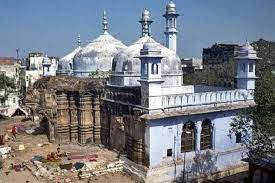The Gyanvapi Mosque in Varanasi has been at the center of a significant legal battle, with profound implications for religious sentiments and cultural heritage. The Allahabad High Court’s verdict on the Archaeological Survey of India (ASI) survey has been eagerly awaited, given the sensitive nature of the case and its potential impact on communal harmony. This article delves into the historical background of the Gyanvapi Mosque case and its significance, leading up to the verdict day.
The ASI Survey Order: Unraveling the Past
The Gyanvapi Mosque, located adjacent to the revered Kashi Vishwanath Temple, has long been a site of historical curiosity and religious debates. On July 21, a Varanasi court issued a directive to the ASI, ordering a comprehensive survey to determine whether the mosque was constructed upon a pre-existing Hindu temple. This order was met with both anticipation and apprehension, as the ASI embarked on the challenging task of excavations and historical research.

Suspense and Halt: Supreme Court’s Intervention
The ASI commenced its survey on July 24, but the Supreme Court intervened, ordering a temporary halt until July 26. The court cited the need for “breathing time” to allow an appeal to a district court order. This suspension added to the already heightened suspense surrounding the case and raised questions about the direction the verdict might take.
The Government’s Assurance: Preserving the Structure
Amidst growing concerns about potential alterations to the mosque’s structure, the Indian government assured the Supreme Court that the ASI’s survey would not cause any harm to the existing mosque. Solicitor General of India, Tushar Mehta, clarified that the survey would be limited to measurements, photography, and radar studies. Despite this assurance, anxieties lingered among various stakeholders about the outcome of the survey and its potential consequences.
A Petition that Changed the Course: Women’s Plea for Worship
The case took an interesting turn when a group of women approached the court seeking permission to worship Hindu deities within the mosque complex. Their plea was based on historical records suggesting the presence of a temple at the site before the construction of the mosque. The court responded by ordering a video survey in 2022, during which a structure resembling a ‘shivling’ was discovered, further intensifying the legal battle.
Disputing the Claim: Mosque Management Committee’s Response
In response to the claim of a ‘shivling,’ the mosque management committee contested the assertion, stating that the structure was part of a fountain in the ‘wazukhana,’ an area designated for worshippers to wash their hands and feet before praying. This contradiction added to the intricacies of the case, as the court grappled with differing narratives.
Sensitive Measures: Sealing of the Alleged ‘Shivling’ Area
Given the sensitivity of the case, the Supreme Court ordered the sealing of the alleged ‘shivling’ area until a final verdict was reached. This measure aimed to prevent any further dispute or unrest surrounding the contested structure within the mosque complex.
Legal Challenges: Maintainability of the Committee’s Petition
In September 2022, the Varanasi district court dismissed the mosque committee’s challenge to the women’s petition, asserting that their request to worship Hindu deities inside the mosque complex was not maintainable. This dismissal further complicated the case and highlighted the complex legal landscape surrounding the Gyanvapi Mosque.
Allahabad High Court’s Decision: A Momentous Verdict
The verdict day finally arrived, and the nation awaited the Allahabad High Court’s decision with bated breath. The judges meticulously weighed historical evidence, legal arguments, and constitutional principles of religious freedom in their deliberations. The judgment carried far-reaching implications, not only for the Gyanvapi Mosque but also for India’s cultural heritage and communal harmony.
Reactions and Implications: A Divided Response
The court’s verdict evoked mixed reactions from different sections of society. Supporters of the ASI survey celebrated the validation of their claims, emphasizing the importance of historical accuracy. On the other hand, those concerned about religious coexistence and the preservation of the mosque’s sanctity expressed apprehensions over potential repercussions.
Political Significance: Gyanvapi Mosque in Modi’s Constituency
Situated in Prime Minister Narendra Modi’s constituency, the Gyanvapi Mosque holds additional political significance. Its historical relevance and contentious nature have made it a topic of political debate over the years. The case has been viewed through various political lenses, and its resolution could have implications beyond the religious and cultural realms.
As the dust settles after the verdict, the Gyanvapi Mosque remains a symbol of India’s diverse heritage and the need for careful and thoughtful dialogue. The case highlights the challenges of reconciling historical research, religious sentiments, and cultural preservation. The verdict day marks the beginning of a new chapter in India’s ongoing quest for historical truth and religious harmony. It is imperative for all stakeholders to engage in constructive dialogue and work towards mutual respect and understanding. Together, we can cherish our shared history and build a future that upholds the values of diversity, inclusivity, and harmony. The Gyanvapi Mosque case serves as a reminder of the delicate balance required to navigate through India’s rich tapestry of culture and history.













